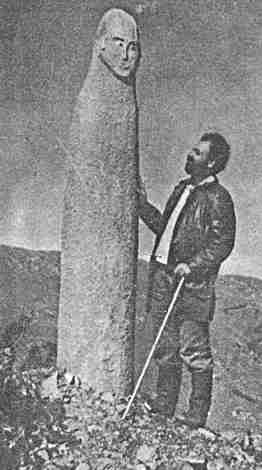Back
In Russian
Contents Türkic languages
Codex of Inscriptions - Index
Alphabet - Index
Roots
Alphabet
Writing
Language
Religion
Geography
Archeology
Coins
Wikipedia
Hunnic Writing
Turanian Writing
Paleography of 8 Türkic Alphabets
Avar Dateline
Besenyo Dateline
Bulgar Dateline
Huns Dateline
Karluk Dateline
Kimak Dateline
Kipchak Dateline
Kyrgyz Dateline
Sabir Dateline
Seyanto Dateline
Paleography of 8 Türkic Alphabets · Codex of Inscriptions-Euro Asiatic- Don · Codex of Inscriptions-Euro Asiatic- Kuban
The name of the outstanding paleontologist and Türkic philologist Soslanbek Baichorov belongs to those few selected scientists who dedicate their life to the man-made enigma of the Türkic writings. In his book, Ancient Türkic Runic Monuments of Europe, Soslan Baichorov provided readings for around 150 inscriptions, demonstrating a wide spread of the Türkic literacy in the Eastern and Central Europe, the giant spread of the Türkic inscription monuments, and the ethnic affiliation of the studied texts with the "d" and "dj" dialects of the Bulgarian language over the vast steppe expanses from Itil to Danube. S. Baichorov de-mystified the inscriptions attributed by the archeologists to the Alanian populations of the Khazaria, finding them to be legibly written in the Bulgarian language and detecting the dialectal nuances of it. And, to be able to accomplish the decipherment of the North Caucasian and Northern Pontic inscriptions, S. Baichorov had to establish the alphabetical specifics of the differing scripts of the different schools of writing, and the grammatical rules used in the conventional writings.
Stone statue of the ancient ruler (latest find of the Author in the Biychesyn)

Photo from the book
Soslanbek Baichorov
ANCIENT TÜRKIC RUNIC MONUMENTS OF EUROPE
STAVROPOL, 1989
Unannounced edition.
Published copies: 1,000
Table of contents |
|
| Chapter 1 Relation of Ancient Turkic runiform writing in North Caucasus area to Volga-Don and Danube areas (Introduction) | 7 |
| § 1. Ancient Turkic rules for spelling of vowels and modern readings of western Turkic runiform inscription monuments | 7 |
| § 2. History of discovery the North Caucasian area ancient Turkic runiform writings | 20 |
| § 3. Methods of decoding | 29 |
| § 4. Migration of Bulgars, carriers of runiform script | 33 |
| § 5. Overview and conclusions | 37 |
| Chapter 2. Decoding of North Caucasian, Volga-Don and Danube runiform inscriptions | 39 |
| Chapter 3. Descriptions, transcriptions and translations of Danube, Volga-Don and North Caucasian Turkic runiform monuments | 93 |
| § 1. Inscriptions on Nagy-Szent-Miklos or so-called "Atilla treasury" golden vessels | 94 |
| § 2. Fragment of inscription on a slab from Homorodkaratson settlement in Transylvania | 134 |
| § 3. Inscription from Shumen | 135 |
| § 4. Signs and groups of signs on slabs from Abob-1 in Pliska | 136 |
| § 5. Inscription on spinner from Burgegnland | 136 |
| § 6. Inscriptions from Murfatlar | 137 |
| § 7. Inscriptions on flasks from Novocherkassk museum | 145 |
| § 8. Inscriptions on slabs in Mayak fortress | 154 |
| § 9. Inscription on amphora from Mayak fortress | 160 |
| § 10. Inscriptions on objects from Sarkel | 161 |
| § 11. Inscriptions from Khumara fortress | 166 |
| § 12. Inscriptions from cliff burial in Khasaut gorge | 186 |
| § 13. Epigraphical monuments from cliff burial in Gnakyzy gorge | 203 |
| § 14. Inscriptions in Bitikl | 214 |
| § 15. Inscriptions on Ak-Kaja cliff in Gestenti gorge | 215 |
| § 16. Inscriptions from cliff burial in Inal canyon | 219 |
| § 17. Inscriptions from cliff burials at Tokmak-Kaya cliff | 226 |
| § 18. Arkhyz Inscriptions | 233 |
| § 19. Inscription on spinner from Ullu-Dorbunla fortress | 239 |
| § 20. Inscription from Karakent fortress | 241 |
| § 21. Inscription on a slab from Kalej fortress | 241 |
| § 22. Inscriptions from cliff burial in Teshikle gorge | 242 |
| § 23. Inscriptions on cliff panorama in Sutul canyon | 247 |
| § 24. Inscriptions from the Bilyar fortress | 251 |
| § 25. Results of the paleographic analysis | 254 |
| Chapter 4. Language form in North Caucasian, Volga-Don and Danube runiform inscriptions | 257 |
| § 1. Grapho-phonetic features | 257 |
| § 2. Dialects of North Caucasian runiform monuments | 264 |
| § 3. Morphological features in language of North Caucasian runiform inscriptions | 266 |
| § 4. Lexical features in language of North Caucasian runiform monuments | 275 |
| § 5. General conclusions about linguistic affiliation of North Caucasian runiform monuments | 277 |
| § 6. Relationship between languages of Volga-Don and N.Caucasian monuments | 278 |
| § 7. Relationship between languages of Danube and N.Caucasian runiform monuments | 279 |
| Conclusion | 281 |
| Sources and abbreviations | 283 |
| Literature | 283 |
| Abbreviations | 290 |
| Languages, dialects, vernaculars | 291 |
| Transcription alphabet | 292 |
| Symbols | 292 |